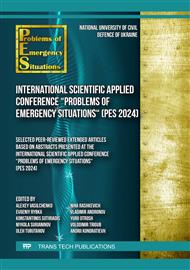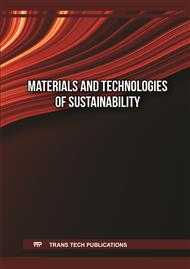[1]
S. Guzii, Studies of the effect of viscosity stabilizers of fire-retardant aluminosilicate paints for wood products and structures. Journal of Modern Technology and Engineering. 6 (1) (2022) 24-33.
Google Scholar
[2]
S. Guzii, Fire Protection of Wood and Structures with Mineral Paints. Trends Tech Sci Res. 5(5) (2022) 555671.
Google Scholar
[3]
S. Guzii, Reducing the Combustibility of Wood Products by Treating their Surface with Intumescent Paints on a Water-Dispersion Basis. Trends Tech Sci Res. 6(1) (2023) 555676.
DOI: 10.19080/ttsr.2023.06.555676
Google Scholar
[4]
P. Yin, H. Cai, W. Liao, et al., Design and preparation of flame-resistant geopolymer coatings for timber. J Mater Sci.. 58 (2023)13865–13874.
DOI: 10.1007/s10853-023-08886-6
Google Scholar
[5]
W. Ya Chao, et al. Nano-ZnO modified geopolymer composite coatings for flame-retarding plywood. Construction and Building Materials. 338 4 (2022) 127649.
DOI: 10.1016/j.conbuildmat.2022.127649
Google Scholar
[6]
J. Temuujin, W. Rickard, M. Lee, A. van Riessen, Preparation and thermal properties of fire resistant metakaolin-based geopolymer-type coatings. Journal of Non-Crystalline Solids. 357 5 (2011) 1399–1404.
DOI: 10.1016/j.jnoncrysol.2010.09.063
Google Scholar
[7]
F.U.A. Shaikh, S. Sharany, J. Haque, Sanjayan, Behavior of fly ash geopolymer as fire resistant coating for timber. Journal of Sustainable Cement-Based Materials. 8:5 (2019) 259–274.
DOI: 10.1080/21650373.2018.1537015
Google Scholar
[8]
M.S. Mohd Basri, F. Mustapha, N. Mazlan, M.R. Ishak, Rice-Husk-Ash-Based Geopolymer Coating: Fire-Retardant, Optimize Composition, Microstructural, Thermal and Element Characteristics Analysis. Polymers. 13 (2021) 3747.
DOI: 10.3390/polym13213747
Google Scholar
[9]
V.A. Voytovich, Protection of wood from burning. J. StroyPROFIL. 2 (48) (2006) 12–21.
Google Scholar
[10]
S. Guzii, I. Bazhelka, N. Svitlychna, V. Lashchivskiy, Protection of Wood from Burning with Paints on Alkaline Aluminosilicates-Based. Materials Science Forum. 1006 (2020) 19–24.
DOI: 10.4028/www.scientific.net/msf.1006.19
Google Scholar
[11]
S. Guzii, T. Kurska, et al. Features of the organic-mineral intumescent paints structure formation for wooden constructions fire protection. IOP Conf. Ser.: Mater. Sci. Eng. 1162 (2021) 012003.
DOI: 10.1088/1757-899x/1162/1/012003
Google Scholar
[12]
P. Kryvenko, V. Kyrychok, S. Guzii, Influence of the ratio of oxides and temperature on the structure formation of alkaline hydro-aluminosilicates. Eastern-European Journal of Enterprise Technologies. 5(5–83) (2016) 40–48.
DOI: 10.15587/1729-4061.2016.79605
Google Scholar
[13]
S. Guzii, P. Kryvenko, O. Guzii, S. Yushkevych, Determining the effect of the composition of an aluminosilicate binder on the rheotechnological properties of adhesives for wood. Eastern-European Journal of Enterprise Technologies. 6/6(102) (2019) 30–37.
DOI: 10.15587/1729-4061.2019.185728
Google Scholar
[14]
S. Guzii, Investigation of the influence of organomineral additives on the colloid-chemical properties of geocement dispersion. Technology audit and production reserves. 3/1(35) (2017) 38-43.
DOI: 10.15587/2312-8372.2017.105678
Google Scholar
[15]
E.N. Glazacheva, M.V. Uspenskaya, Colloidal chemistry. Methodical instructions for laboratory work. ITMO University, St. Petersburg. (2015) 62.
Google Scholar
[16]
A. Kravchenko, S. Guziy, Determining the fire resistance properties of timber, protected by geocement-based coatings. Eastern-European Journal of Enterprise Technologies. 1(5) (2015) 38–41.
DOI: 10.15587/1729-4061.2015.36843
Google Scholar
[17]
DSTU B V.2.7-19-95 (GOST 30244-94). Construction materials. Test methods for flammability.
Google Scholar
[18]
N.O. Duzhylova, Physical and chemical features of structure formation of gas-silicate matrix in the system "CaO-Al2O3-Ca(OH)2-SiO2-Al-FeMn-H2O". Resource-efficient materials, structures, buildings and constructions. 22 (2011) 56–62.
Google Scholar
[19]
J. Kruželák, A. Kvasničáková, K. Hložeková and I. Hudec, Progress in polymers and polymer composites used as efficient materials for EMI shielding. Nanoscale Adv. 3 (2021) 123.
DOI: 10.1039/d0na00760a
Google Scholar



